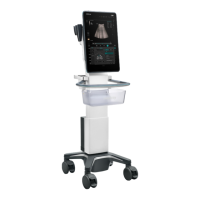6 Image Acquisition
Operator’s Manual 6 - 27
harmonic frequency much more efficient than the surrounding tissue. Blood containing the contrast
agent stands out brightly against a dark background of normal tissue.
• Set MI index by instructions in the contrast agent accompanied manual.
• Read contrast agent accompanied manual carefully before using contrast
function.
• Make sure to finish parameter setting before injecting the agent into the patient to avoid
affecting image consistency. This is because the acting time of the agent is limited.
• The applied contrast agency should be compliant with the relevant local regulations.
6.14.1 Basic Procedures for Contrast Imaging
Perform the following procedure:
1. Select an appropriate probe, and perform 2D imaging to obtain the target image, and then fix
the probe.
2. Select [Contrast] to enter the contrast imaging mode.
3. Adjust the acoustic power experientially to obtain a good image.
Set [Dual Live] to be “On” to activate the dual live function. Observe the tissue image to find
the target view.
4. Inject the contrast agent, and set [Timer 1] at “ON” to start the contrast timing. When the timer
begins to work, the time will be displayed on the screen.
5. Observe the image, use [Pro Capture] and [Retro Capture] button to save the images.
Select the Freeze button to end the live capture.
Perform several live captures if there are more than one interested sections.
For setting cine length in contrast imaging mode, see the Setup chapter.
6. At the end of a contrast imaging, set [Timer 1] at “OFF” to exit the timing function.
Perform steps 3-6 if necessary.
For every single contrast imaging procedure, use [Timer 2] for timing.
If necessary, activate destruction function by setting [Destruct] at “ON” to destruct the micro-
bubbles left by the last contrast imaging; or to observe the reinfusion effect in a continuous
agent injecting process.
7. Exit contrast imaging.
Select the B mode button to return to B mode.
6.14.2 Left Ventricular Opacification
Perform the following procedure:
1. Acquire ECG signal.
2. Select an appropriate probe and LVO exam mode.
3. Adjust the acoustic power experientially to obtain a good image.

